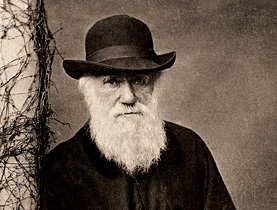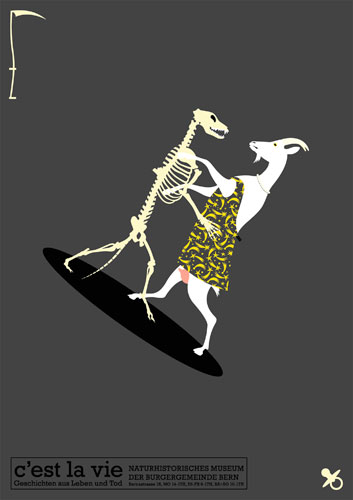Celebrating the genius of Darwin

Why don't women grow beards? Why don't men have tails like peacocks? An exhibition on evolution at the Bern Natural History Museum explains all.
“Once upon a time there was a finch – 150 years of the theory of evolution”, runs until October 31 and is one of many events taking place in Switzerland throughout the year, which marks the 200th anniversary of the great British naturalist’s birth.
“Darwin was a genius in a lot of areas, but what he did was have a really deep look at things. He started to observe nature and write about what was happening around him – he then put all the pre-existing knowledge together into a theory,” Mandana Roozpeikar, curator of the exhibition, told swissinfo.
“So he didn’t really develop anything new, he just assembled everything like a nice puzzle and made a new picture.”
By pointing out that all species evolved over time from common ancestors and that humans were nothing more than naked apes, Darwin’s theory had two main consequences: It did away with the need for a supernatural creator, and it knocked humans off their pedestal.
“What Darwin said 150 years ago changed the world,” Roozpeikar said. “Previously everyone thought ‘OK, there’s a god who created everything’ and that was it – everything was constant, species didn’t change. Then someone comes along and throws into doubt what had been accepted for 2,000 years.”
Indeed, the title of the exhibition is a pun: the German word for finch, Fink, is also an old Swiss term for scoundrel.
“Only now with the knowledge of evolution do you start to understand the mechanisms in biology,” she added.
This echoes the view of the eminent American palaeontologist GG Simpson, who once said any attempts before 1859 to explain why people existed were “worthless”.
Challenge
According to Roozpeikar, the greatest challenge in putting together the exhibition was “breaking down the book”.
“[The Origin of Species] is not actually complicated but it is thick. To break it down to a level where you still understand the theory but you’re not getting too bored with all the information, that was the tough part,” she said.
To that end, the exhibition focuses on the three central mechanisms of evolution: mutation, variation and selection (see box).
Under mutation, visitors learn among other things about eye colour – a one-off genetic copying error around 6,000 years ago resulted in blue eyes.
The spectacular variety of observable characteristics thrown up by these random mutations can be seen in the range of stuffed common buzzards on display, from the light-coloured, which tend to occur in northern Europe, to those with large amounts of the pigment melanin.
Selection on the other hand, whether artificial or natural, is emphatically not random. Animal breeders carefully pick individuals with the characteristics they want; in nature it is the “survival of the fittest”, to use the phrase coined by British philosopher Herbert Spencer.
Visitors can compare the strikingly different skeletons of an Irish wolfhound and a chihuahua, two of an estimated 400 dog breeds that evolved from a common ancestor, the wolf, some 14,000 years ago.
School classes
The finches in the exhibition’s title appear in a section on how new species originate. Stuffed examples from the Galápagos Islands show the subtle differences in beak shapes that played a central role in the penny dropping for Darwin.
There is also a six-minute film, aimed at teenagers, explaining how the first finches were probably blown to the Galápagos by a storm, splitting the reproductive community – the first stage of speciation. The film’s title? Gone with the Wind…
“We tried to get objects which are interesting to look at and which break down the information so that 14- or 15-year-olds, who have studied evolution at school, can understand it,” Roozpeikar said.
“We expect a lot of school classes, so biology teachers will be happy that they have some examples to explain the details of evolution in an easy way. But at the same time it obviously has to be scientifically correct.”
“Monkey question”
Despite there being as much scientific doubt about evolution as there is about the earth being round, it is far from generally accepted.
In 2006 an international survey by the journal Science found that one in three Swiss thought it was “definitely false” that humans developed from earlier species of animals (see related stories). In Europe only Austrians were less enlightened.
An unrepresentative poll by swissinfo (see right) has come to a similar figure.
Reasons for this rejection of solid evidence include a general problem with massive numbers – the millions of years involved in evolution are hard for most people to comprehend – and a natural tendency to see cause and effect where there is none, resulting in the popularity of the intelligent design fallacy.
For Roozpeikar however “it’s the monkey question”.
“I think a lot of people are afraid if they think monkeys and humans have the same relatives,” she said.
Debate
Religious issues and the “meaning of life” are addressed in a video wall where scientists and theologians hold a 25-minute debate moderated by a popular talk-show host.
“At the previous exhibition I did we had biology classes but also a lot of confirmation classes,” Roozpeikar said. “It was very interesting to see the debate after the video discussion. I would ask the children to stand where they believed was correct – a lot of children stood on the creationist side.”
This part of the exhibition is disappointing for people who don’t think religion should be given a platform in a scientific context – suggesting a controversy where there is none – but in general “Once upon a time there was a finch” does a fine job of clearly explaining the basics of something every human should understand.
As for whether Darwin was responsible for the most important scientific theory ever, Roozpeikar gives a very Swiss answer: neutral and optimistic.
“In biology definitely, but there are other great people in other disciplines – Copernicus for example,” she said.
“And maybe there are still more great people to come.”
swissinfo, Thomas Stephens
Charles Robert Darwin was born in England on February 12, 1809, into a family of doctors.
Having studied medicine and theology, he turned to natural history and in 1831 joined the HMS Beagle on an expedition to chart the coastline of South America.
The voyage lasted almost five years, with Darwin spending most of the time on land investigating geology and making natural history collections, which he sent home.
In 1859 he published his seminal work “On the Origin of Species by Means of Natural Selection, or the Preservation of Favoured Races in the Struggle for Life”.
In 1872 he published The Descent of Man, and Selection in Relation to Sex. In this, Darwin set out evidence that humans are animals.
Darwin died on April 19, 1882. He was given a state funeral and buried in Westminster Abbey, close to Sir Isaac Newton.
In September 2008 the Church of England issued an article saying that the 200th anniversary of his birth was a fitting time to apologise to Darwin, a self-confessed agnostic, “for misunderstanding you and, by getting our first reaction wrong, encouraging others to misunderstand you still”.
All living organisms – from humans to mountain goats to edelweiss – are distant cousins and have evolved, through random genetic mutations and the non-random process of natural selection, from a single self-replicating molecule that popped into existence by chemical chance some 3.5 billion years ago.
In natural selection, organisms with traits that are best suited (“fittest”) to their particular environment are more likely to survive and reproduce than their rivals. Thus genes, the units of inheritance, that build successful “survival machines” get passed on and fill up the gene pool more than less successful genes.
Natural selection takes places within species not between species.
Evolution via natural selection explains how simple organisms can, over millions of years, result in complex organisms seemingly designed for their environment without requiring any supernatural designer or creator.

In compliance with the JTI standards
More: SWI swissinfo.ch certified by the Journalism Trust Initiative














You can find an overview of ongoing debates with our journalists here . Please join us!
If you want to start a conversation about a topic raised in this article or want to report factual errors, email us at english@swissinfo.ch.